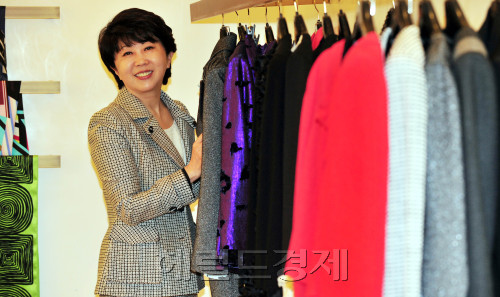Lee Kwang-hee seeks donations for Sudanese to ease hunger with mangos
Fashion designer Lee Kwang-hee has made clothes for the richest in society, including former and current first ladies.
Two years ago, she rolled up her sleeves not to sew dresses but to grab a garden trowel in Africa. She planted mango trees in one of Sudan’s poorest areas to help people living in the troubled Sudanese village of Tonj.
Her trip to Sudan was not intended from the beginning. Kim Hye-ja, a famous actress and one of her clients, suggested that they go together in March, 2009. Kim was a long-time goodwill ambassador for World Vision Korea, an international relief agency. But planting mango trees in a country so far from Korea was the last thing Lee expected to do.
 |
Fashion designer Lee Kwang-hee is helping people living in the troubled Sudanese village of Tonj. (Kim Myung-sub/The Korea Herald) |
Of course, she was not without ties to charity. She had held fashion shows for old people in poverty and patients suffering from rare diseases, but it was her first visit to such a scene.
“I wondered why Kim went there almost periodically and wanted to see directly what World Vision was doing,” Lee told The Korea Herald.
“To begin with, the journey is long and exhausting. You have to transfer at Dubai to go to Kenya, where you take a small light aircraft to enter Tonj.”
Once there, she and other volunteers stayed in tents.
“I saw a desolate environment, and people were living there with little food. They collect edibles only from the sterile land. Hunger is engraved in their lives. Worse still, cholera takes many lives.”
There was indeed nothing to eat. She pondered how to solve the scarcity of food. She went to a market, where she found mangos on sale. She asked when mango trees bear fruit. Twice a year, she was told, and that fruits can be harvested for the first time five years after being planted. Better yet, the tree lives for 100 years, and is tall like a zelkova, giving welcome shade. She knew she had found what she had been looking for.
“I thought at that time that the people there needed to plant the trees first of all to ease their hunger and to help drive out infectious diseases,” Lee said.
She bought 100 mango seedlings on the spot, which she planted together with the residents. Now, 100 households had one mango tree apiece.
After returning to Seoul, she sought to raise funds together with World Vision. It cost $15 to plant a mango seedling. In November, 2009, she held a charitable fashion show at Hyatt Hotel to raise funds for her project to plant mango trees in Sudan. Emphasizing that mango trees can save children in Tonj from hunger, she persuaded many people to join her effort. In February, 2010, she founded “Himango,” a charity organization to plant the trees of hope in Africa. In October of the same year, Lee held a Himango-themed fashion show at the National Theater.
“Mango is a nutritious fruit. Mango trees are a godsend to them. They can grow well in the Sudanese environment. To buy them mango seedlings is a 100-year investment,” she said.
When she visited Tonj again last summer, she distributed 15,000 seedlings. She plans to go there in July this year to plant 12,000 saplings, which are being cultivated in six local fields.
On her second visit, she was surprised to see the landscape changed beyond recognition. It was the wet season. The sterile land was nowhere. Instead, thick woods and grasses came into her sight. The rainy season was a period of abundance to the people living there. “If I had been here in the rainy season, I wouldn’t have thought of mango trees,” she said.
She took ballpoint pens and balloons with her to give Tonj residents as a gift. “The airplane I took was so small that it could load six people, including the two crew members. So I carried the pens and balloons because they were light.” She and children played with balloons. “The children had nothing to play with. They had real fun playing balloon games,” she said. “Little things to us are big and important to them.”
Charitable blood seems to flow in her veins. Her late father, Lee Joon-mok, was a pastor who built a facility for homeless children in Haenam, South Jeolla Province. He also founded a welfare foundation for the aged. Her late mother, Kim Su-deok, lived a frugal life helping those in need together with her pastor husband. Lee’s mother was good at sewing clothes, but she made clothes for poor people. Two sets of traditional Korean dress made from modest cotton cloth were all she wore throughout her lifetime.
“To me, my parents were a model of philanthropy. They always told me not to postpone good deeds, or they will turn evil,” the 58-year-old designer said.
She will hold a bazaar at her boutique near Hyatt Hotel on May 3. It is the first fancy fair she has held since she founded Himango. She will launch diverse small articles designed with her signature. According to Lee, First Lady Kim Yoon-ok is to donate some of her belongings to the bazaar for the Himango project. Popular actors and actresses, including Kim Hye-ja, will contribute their clothes and items to the event.
For more information on the bazaar or the Himango, please call 02-790-7434.
By Chun Sung- woo(
swchun@heraldcorp.com)








![[Today’s K-pop] Blackpink’s Jennie, Lisa invited to Coachella as solo acts](http://res.heraldm.com/phpwas/restmb_idxmake.php?idx=644&simg=/content/image/2024/11/21/20241121050099_0.jpg)